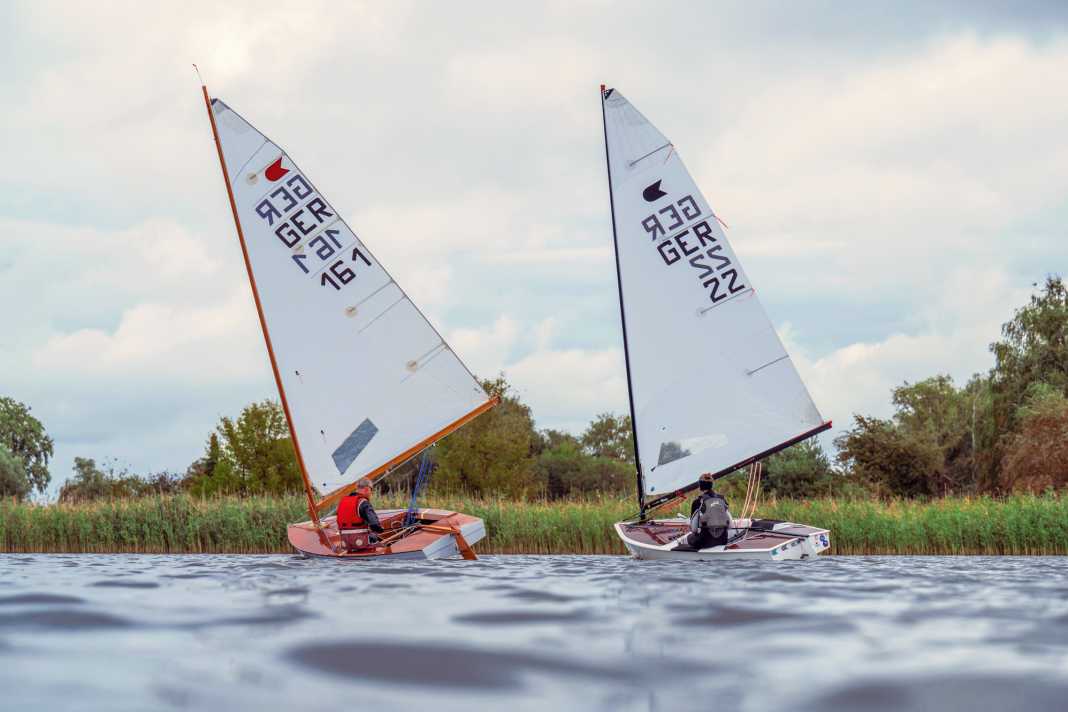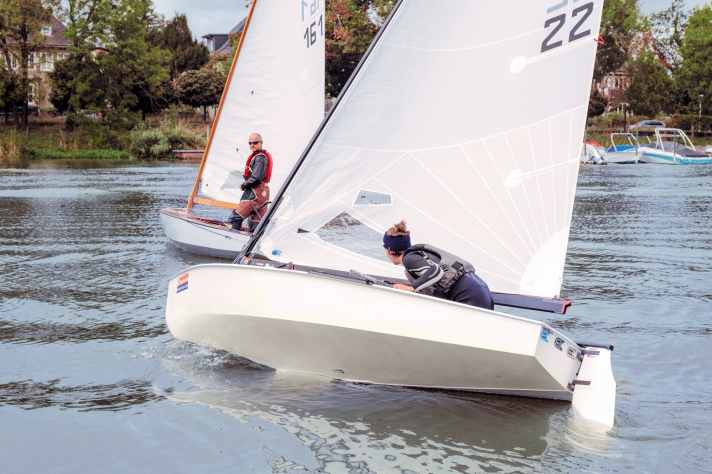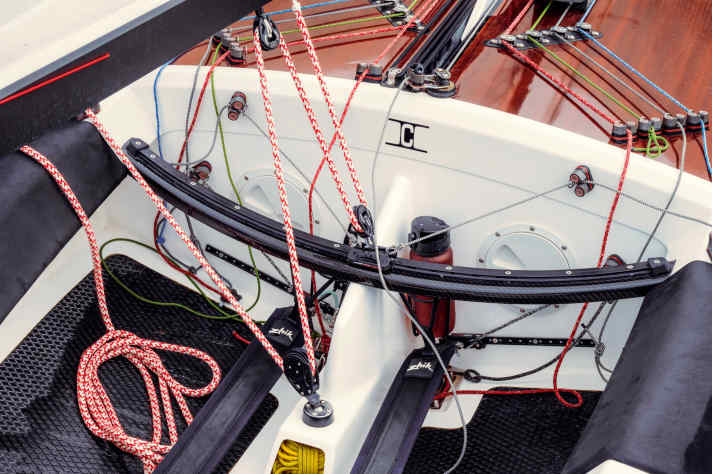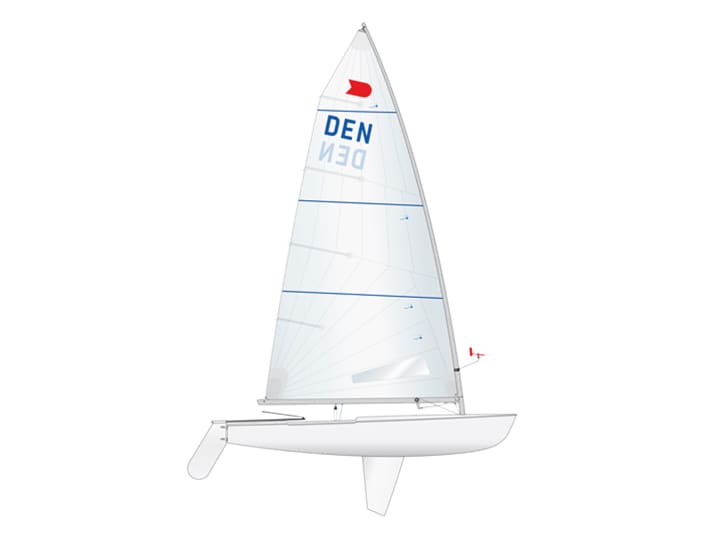Flourishing class: The fascination of OK dinghies - whether made of wood or GRP






"Number 6" is the name of Dirk Gericke's current OK dinghy and says a lot about him and the history of this internationally popular class. Because the name means that it is Gericke's sixth OK dinghy. Anyone who knows that these boats last a long time can imagine that Gericke has been loyal to the dinghy for a long time. "I simply really enjoy sailing it," says the 59-year-old. Although he also sails regattas in the O dinghy, the Finn, the Ixylon and the Pirate, this is his favourite class. "I have the most confidence in the OK dinghy. Although it is by far the most tippy of my boats!"
The Danish yacht designer Knut Olsen designed it in 1956 as a light and fast single-handed dinghy. The new boat quickly became popular and was recognised as an international class within a few years. The first world championship was held as early as 1963. In the two decades that followed, the OK dinghy was very popular, with over 10,000 boats sold internationally and large regatta fields. Later, the small articulated dinghy was even considered as an Olympic boat class, but was ultimately beaten by the Finn dinghy. And so the two letters in the name do not stand for "Olympic class", as is often assumed, but simply represent the initials of the Danish designer Knut Olsen.
With over 15,000 units built internationally, it was even being discussed as an Olympic class
The OK dinghy was the official standardised class in the GDR
Dirk Gericke also joined the class in its heyday. Although: "I don't actually remember choosing it. But that was a good thing," he says dryly. After years in Optimists, Pirates and 420s, his father had ordered an OK dinghy for him. Not entirely without reason: Rolf Gericke had been making sails for OK dinghies for many years. The dinghy with the two letters in its name was the official youth single-handed class of the GDR. The GDR squad sailors often came to Rolf Gericke to optimise their sails.
The fact that his son Dirk Gericke is still at home in this class over 40 years later is immediately apparent on the water. He moves smoothly on the four-metre-long boat, casually heeling it to windward on the space wind course and adapting it to the constantly changing wind conditions on his home waters, the Beetzsee in Brandenburg.
The current sailmaker from Brandenburg became GDR champion in the OK dinghy back in 1982, the boat class accompanied him during his military service, his apprenticeship as a sailmaker and the start of his family, and he remains loyal to the class even as a grandfather.
The OK dinghy used to be made of wood, today it is made of GRP
The "Number 6" is a modern boat, with a GRP hull, carbon mast and aluminium boom. "But I needed a bit of wood," says Gericke mischievously, pointing to the deck of his dinghy. The otherwise white deck is decorated with mahogany veneer. The GER 161, on the other hand, has a lot more wood on display. The 50-year-old OK dinghy not only has a wooden hull, the rig and rudder are also made of wood, true to the original. Only the centreboard was replaced at some point and is now made of aluminium.

However, if you saw GER 161 and "Number 6" sailing side by side, you would never guess that there is an age difference of almost 40 years between them. The older "161", as it is called by club members, glides gracefully through the water, while the much newer "Number 6" looks somehow chunkier. "The hull of the 'Number 6' is actually slightly wider," explains Dirk Gericke, who has owned the dinghy since 2018. "But the class regulations don't actually allow much play, just a few millimetres."
On board the "161", however, you realise that you are sitting on an ageing dinghy. The tiller boom cannot be moved anywhere near as freely as the modern ones with rubber joints. What's more, the boom is inserted through the wooden mast. When the sheet is unfurled, the whole mast rotates, and only with difficulty. Again and again you have to lean on the foredeck to push out the sail, and the additional movement on board naturally results in a loss of speed.
Modern boats are lighter and faster
The dinghy is almost reminiscent of an elderly person who is still fit, but no longer as agile. And yet she slips to leeward of the "number 6" from time to time. In gusts, the "161" leans leisurely to leeward, and the sudden increase in rudder pressure has to be compensated for by hanging on. Both boats accelerate, but the newer "Number 6" manages the speed better. She puts metres and metres between herself and her older sister. In addition to significantly more trimming equipment and modern material, this may also be due to the weight: "Number 6" weighs the minimum weight of 72 kilograms. "The other one here probably weighs 80 kilos," estimates Gericke.
In fact, there are always older OK dinghies in regatta fields, he reports. "That's the great thing about the boat," he says proudly. "You can take it out of the garage again after 20 years and off you go. You might not win a flower pot, but you can sail."
The international class associations always endeavour to formulate the class rules in such a way that the regattas also remain open to older boats. Sailors should be able to take part in national and international regattas "right down to the wooden mast". And Gericke should know: he has been the chairman of the OK dinghy association for Berlin and Brandenburg since the 1990s.
The OK class is booming internationally
However, the sailmaker is concerned about his area of responsibility. The regattas in Berlin and Brandenburg are chronically poorly attended and you always have to travel from here for large regatta fields. For this reason, Gericke gave an incendiary speech at a meeting of the class association in spring: "We need you!", he said and cordially invited everyone to the OK dinghy regatta organised by his home club. With success: almost 30 participants registered.
"I was extremely proud," says Gericke, "that's real solidarity." Overall, the mood in the class seems to be good and it is booming internationally. According to the website of the international class association: "The fact that more boats have been built in each of the last three years than in any other year since 1980 shows that this timeless class is in excellent condition." Over 140 participants took part in this year's world championship in England - numbers that most other dinghy classes can only dream of.
Another reason for this is that motivated hobby boat builders can make the dinghy themselves with the help of kits. The plans for CNC-milled construction parts can be purchased directly from various suppliers in Europe and Oceania. After that, it takes a little boat-building skill, time and sufficient space, but then the self-builds can certainly hold their own in the regatta field. They have even won world championship titles several times in recent years.
Influx from the Finn dinghy class
Another reason for the current high level of interest in the OK dinghy is the cancellation of the Finn dinghy at the Olympics. Young world-class Finn sailors are now increasingly taking part in OK dinghy regattas and are immediately competitive due to the similarity of the boats. For example, the British Finn sailor Henry Wetherell, who won the world championship title in the OK dinghy this year. The long-established OK sailors might be annoyed by this, but: "It's good for the class," says Dirk Gericke. "The young people are setting new standards in the class, which keeps it attractive."

This appeal of the OK dinghy class is very easy to understand when test sailing the "Number 6". Although the boat has the same dimensions as its wooden predecessor, it feels bigger, somehow more powerful. In light winds on the Beetzsee, it is easy to control even for lightweight sailors, but it feels as if you are driving a powerful car through the traffic lane. Despite the forces at play, the GRP dinghy sails light-footedly in light winds, reacts quickly to tiller movements and accelerates well in sudden gusts.
In light winds, the dinghy feels like you're driving a racing car through the playground
When pulling, it is as if the dinghy starts to luff all by itself. The tiller gently pulls the hand to leeward, as if the boat wants to show the young helmswoman where to go. OK dinghies can actually sail quite high upwind, the newer ones even better than the older wooden dinghies. This is due to trimming devices such as the finely adjustable foot, which can be adjusted both at the front and rear of the boom. But the positioning of the mast also plays a role in the upwind course: in the new boats, the mast is around 20 centimetres further forward. In addition, the position of the mast base on the water can be adjusted on deck, allowing sailors to react flexibly to changing wind conditions.
Every OK dinghy must be sailed differently
It's not so easy to find the optimum windward heel on the OK dinghy downwind. On the one hand, in addition to sensitivity, you need good hull stability to heel the comparatively heavy single-handed dinghy. On the other hand, the optimum heel differs from boat to boat and sail to sail. The older sails are cut relatively straight at the top, and the boom on the older dinghy, which is inserted through the mast, makes fine adjustment of the sail position even more difficult. Anyone sailing the "161" must therefore either be satisfied with one sail position and the corresponding heel of the boat or repeatedly give up the heel in order to adjust the sail position at great expense.
Things look very different with "Number 6": The spreaders for the eight and a half square metre sail are attached to the so-called wing. The arrow-shaped carbon construction is located in front of the mast, allowing the mainsail to be let out very far. This, in turn, makes it easier to sail downwind and heel the boat to windward. As the newer sails are flared further at the top than older models, upwind heeling on downwind courses definitely gives you a speed advantage.
In the sixties, the OK dinghy was almost banned
Dirk Gericke is not entirely innocent in the evolution of the sails in the OK dinghy. By his own admission, the sailmaker from Brandenburg was the first to turn the headboard of the sail round. This allowed him to extend the sail further at the top. "The class rules stated that the sail had to have a headboard like this. There was no description of how to position it," explains Gericke. At the next world championship, there was displeasure about this and the rules were subsequently formulated more specifically. What remained was the possibility of extending sails further up than before.
When a strong gust does sweep across the Beetzsee, it is easy to understand what Gericke's club mate Jörg "Fritze" Engler says about the OK dinghy on both boats. "In strong winds, she sails with me, not the other way round," he jokes, repeating a statement that can be found time and again when researching this boat. It is said that the dinghy's fast and unstable sailing style was also the reason why the Danish Sailing Association almost banned the OK dinghy in the 1960s. But thanks to the vehement persuasion of its many international supporters, this never happened. Luckily, because this dinghy really is a lot of fun.
Text: Luisa Conroy
Technical data OK dinghy
The small, lightweight articulated dinghy is based on an idea by Axel Damgaard Olsen from the USA. He envisioned a simple one-man boat that was easy to build from plywood, with a free-standing, rotating mast and suitable for transport on the roof of a car. The boat quickly became a success, is now widely used internationally and is now built from state-of-the-art materials. However, old examples are also regularly to be found in the regatta fields

- Design engineer:Knut Olsen
- Year: 1956
- Material (old): Plywood
- Material (new):GRP
- International class since: 1963
- Length:4,00 m
- Width: 1,42 m
- Weight (ready to sail): 72 kg
- sail area:8.25 square metres
- Optimal weight sailor: 75 kg
- Distribution: over 15,000 copies
- German Class Association: ok-jolle.de
- International Class Association: okdia.org

